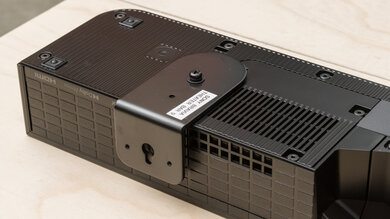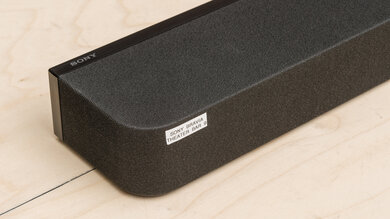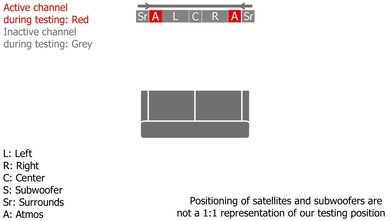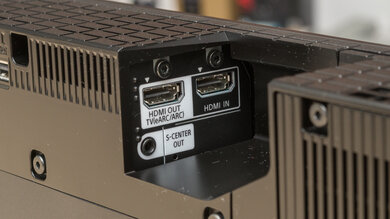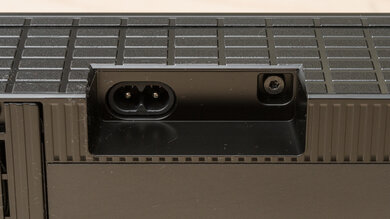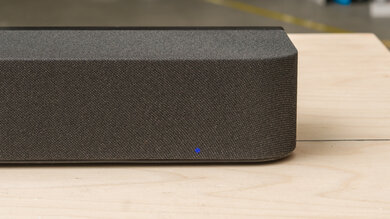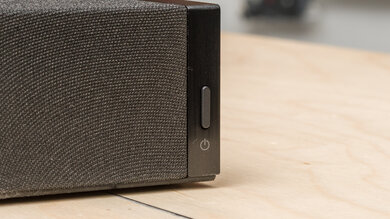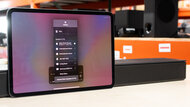The Sony BRAVIA Theater Bar 9 (also known as the Sony HT-A9000) is a premium flagship soundbar from 2024. It doesn't include satellites or a subwoofer by default, so as a standalone bar, it's fitted with features like 360 Spatial Sound Mapping in order to use its phantom speakers to simulate a more immersive sound. It can even upmix stereo content into surround sound, and if you have a compatible Sony BRAVIA TV, you can use it as a center channel alongside the bar.
Our Verdict
The Sony BRAVIA Theater Bar 9 is decent for mixed use. This bar offers a versatile overall performance but, on its own, doesn't outshine its competitors. Since it lacks a subwoofer and satellites, Dolby Atmos-mixed content, like movies, feels a bit less dimensional, while the audio itself lacks low bass. Its soundstage doesn't feel very focused either, so sound effects seem generalized in mixes rather than coming from pinpoint areas. Dialogue sounds clear and easy to follow, though. The bar also supports 4k passthrough at 120 Hz, which is handy if you want to use the bar as a hub between your TV and the latest-gen console, but latency is high via HDMI.
- Supports Dolby Atmos.
- Limited sound enhancement features.
- Disappointing surround performance.
The Sony A9000 is good for dialogue and TV shows. Thanks to its dedicated center channel, it can reproduce dialogue clearly. If you're looking for even clearer vocals, there's Voice Zoom 3, which uses AI to enhance speech. While some latency is present using an HDMI connection, you can use the A/V Sync feature in the companion app to manually compensate for latency. There's also room correction available, allowing the bar to optimize its sound based on your room's unique acoustics.
- Voice enhancement feature available.
- High latency via HDMI In.
The Sony A9000 is okay for music. Out of the box, this bar has a passable frequency response, and it can reproduce clear vocals and instruments. That said, since it doesn't have a subwoofer, it struggles to deliver a thumpy, rumbly low bass, which can be a bit disappointing if you want to feel the bassline in genres like EDM and hip-hop. The sound enhancement features are pretty limited, too, so you can't fine-tune the sound to your liking.
- Supports Spotify Connect.
- Limited sound enhancement features.
Can't get very loud.
The Sony BRAVIA Theater Bar 9 is fair for movies, but this bar doesn't come with a subwoofer or satellites. You can add them to your setup separately for a more immersive sound, though. On its own, the bar supports Dolby Atmos, which is ideal for movies, but its performance isn't anything to write home about. Sound effects are clear and detailed, but lacking in rumbly low bass. Its surround performance isn't anything to write home about either, as it sounds a bit uneven and not very dimensional. The bar also can't get very loud and has compression artifacts at max volume.
- Supports Dolby Atmos.
- Voice enhancement feature available.
- Limited sound enhancement features.
- Disappointing surround performance.
Can't get very loud.
Changelog
- Updated Jul 29, 2025:
We've updated our Sound measurements with Auto Adjust Volume disabled. This reduces max volume, but sidesteps dynamic range issues with the setting enabled.
- Updated Nov 28, 2024:
This review's Wireless Playback box was updated to mention the Sonos Arc Ultra.
- Updated Oct 23, 2024:
The Stereo Soundstage section has been updated to clarify the phase issue found during testing.
- Updated Oct 21, 2024:
The pictograms have been updated to more accurately represent the soundbar configuration. It has been changed from '7.0.2' to '5.0.2' because four of the speakers behave like two pairs, each pair producing the same audio. This is now mentioned in the Compared section. The Sony BRAVIA Theater Bar 9 with Speakers + Bass Module is mentioned in the Surround 5.1 box.
Check Price
Differences Between Sizes And Variants
The Sony A9000 comes in one color variant, Black; see our model's label. You can also purchase it with satellites and a sub, the Sony BRAVIA Theater Bar 9 with Speakers + Bass Module, which performs differently.
If you encounter another variant of this soundbar, let us know in the comments, and we'll update our review.
Popular Soundbar Comparisons
The Sony BRAVIA Theater Bar 9 is a top-of-the-line, standalone bar from 2024 and the larger sibling of the Sony BRAVIA Theater Bar 8. It's also the spiritual successor of the Sony HT-A7000, lacking an Optical port, but offering a bit more compatibility with select Sony BRAVIA TVs. While it shares a similar price point with heavy-hitters like the 11.1.4 configured Samsung HW-Q990D, its overall performance isn't quite as immersive or dimensional as bars with satellites and a subwoofer. The BRAVIA Theater Bar 9 uses four of its drivers in two pairs. So, it effectively operates like a 5.0.2 soundbar, like the Sonos Arc, with each pair handling the same audio channel. That said, it can still deliver some degree of height on Dolby Atmos content like movies, and, unlike the Sonos Arc, it supports 4k passthrough at 120 Hz, which is good if you want to use the bar as a hub between your TV and latest-gen console.
Still looking for more soundbars? Check out our recommendations for the best soundbars, the best Dolby Atmos soundbars, and the best soundbars for movies.
The Sonos Arc Ultra is a better all-in-one bar than the Sony BRAVIA Theater Bar 9. The Sonos is better built and has a more balanced default sound profile (although the Sony's frequency response can be almost as balanced after some calibration). The Sonos has a wider, more immersive soundstage, plus it can get louder with less compression. That said, the Sony has an HDMI In port with the ability to passthrough 4k signals at 120Hz, making it a great option for gamers that want to use it as a hub between their console and display.
For some, the Sonos Arc offers better overall value than the Sony BRAVIA Theater Bar 9. The Sonos can create a wider soundstage with better focus, so you can pinpoint where sound is coming from. Its surround and height performances are better and more even, too. It's even better built, and you can pair it with other Sonos products in your home, but the trade-off is that it only has an HDMI ARC port and comes with an Optical adapter. The Sony soundbar may not have an Optical port, but it has separate HDMI In and Out ports and can passthrough 4k content at 120Hz, which is ideal for gamers wanting to use the bar as a hub between their TV and the latest-gen console.
The Sony HT-A7000 and the Sony BRAVIA Theater Bar 9 are similarly performing bars with a couple of differences to help set them apart. The BRAVIA Theater Bar 9 is intended to be paired with compatible BRAVIA TVs so that you can take advantage of Acoustic Center Sync, which lets you use your TV as a center channel alongside the bar. Additionally, there's also Voice Zoom 3, which is a feature designed to improve dialogue reproduction by amplifying their sound. That said, when it comes to performance, the HT-A7000 has a more premium build, and its stereo soundstage feels more spacious and wide. Some users will also appreciate the Optical connection.
The Sony BRAVIA Theater Bar 9 is a bit better than the Sony BRAVIA Theater Bar 8. It has a more immersive sound, thanks to its two extra R/L speakers, wider soundstage, and better-balanced side-firing speakers. However, it's not substantially better. Both soundbars have mostly the same features, like 4k @ 120Hz passthrough, extensive Dolby Atmos and DTS:X support, and good build quality.
Test Results

The Sony A9000 is quite wide and, unlike the Sony HT-A7000, has most of its sides wrapped in fabric. There are LED lights on the bottom right side of the soundbar.
This bar doesn't come with a subwoofer, but there are quad woofers integrated into the bar's design. You can always add the SA-SW3 or SA-SW5 subwoofers separately, though.
There aren't any satellites part of this setup, but you can add the SA-RS5 or SA-RS3S down the line.
This bar is quite wide, so it won't fit between the legs of a 65-inch TV stand. On the upside, it's not very tall, so it won't block your TV screen unless it's flush to the table. If space is tight, the smaller Sony BRAVIA Theater Bar 8 is a bit smaller with comparable features.
The Sony A9000 has a good build quality. The bar itself is mostly made of hefty plastic, with a fabric covering most of its sides. It doesn't really look or feel like previous Sony soundbars, like the Sony HT-A7000, which has a glass plate on its top side and a metal grille for its front face. That said, it still feels sturdy, although the fabric is prone to collecting dust or hair.
This bar has passable stereo frequency response. It can reproduce detailed and natural-sounding instruments and dialogue, which is good for cinematic cut scenes or daytime soap operas. However, the bar struggles a bit to create separation between instruments. Even though the bar has integrated woofers (not quite subwoofers), they can't quite reproduce thumpy low bass, especially when compared to bars with a dedicated subwoofer like the Samsung HW-Q900D or the Sony BRAVIA Theater Quad with Bass Module. There's no EQ either, but there are sound enhancements that you can use to adjust the sound. You can see a comparison of all the sound enhancements.
If you're looking for a more balanced sound, you can try setting the bass to 'Mid' (which corresponds to the '0' in our comparison). It's worth noting that treble adjustments aren't available, but there is bass and mid.
The stereo soundstage is okay. The width of the soundstage is a little bit wider than the bar itself but not much more than that. If you're not sitting in the middle of the bar, this will impact the stereo performance. The focus isn't very controlled either, so the sound at the edge of the soundstage gets pushed to the back of the soundbar.
The soundbar exhibits a subtle phase issue where audio that's hard-panned to the left or right will still come out of the other channel, albeit at a lower volume. If you're attuned to the specific mix of a track, you'll possibly notice it, especially with older stereo mixes that frequently place an instrument solely on one side of the stereo mix. However, this is less of an obvious issue with most audio since most modern stereo content typically includes sounds to a greater or lesser degree in both L/R channels anyway.
The Sony A9000 can't get very loud. There's a lot of compression at max volume, which can affect your sound's clarity. You're better off going with the Sonos Arc Ultra if you plan on cranking the volume and want to keep your audio pure.
This bar has dynamic range compression (DRC) set to 'auto' by default, but this feature is turned off for testing.
Note: The bar can get quite a bit louder with the 'Auto Adjust Volume' setting enabled. However, users have reported that this crushes dynamic range, so we've opted to keep the setting disabled.
This bar has a center channel, which helps improve vocal reproduction. The frequency response here is quite flat and balanced, so dialogue sounds clear and easy to follow.
If you have a compatible Sony BRAVIA TV, you can take advantage of Acoustic Center Sync. This feature lets you use the TV as a center channel at the same time as using the bar. Don't get your hopes up, though—not only does its efficacy depend on your TV, but in our experience, this feature doesn't really improve your setup's performance, even with a high-end TV. Instead, it can make audio seem flatter. For a clearer and more dimensional experience, we found that using the soundbar setup alone resulted in the best sound.
The Sony A9000's surround performance is disappointing. This bar has side-firing speakers to simulate surround sound, but this doesn't sound as clear or real as a discrete setup. The frequency response of these speakers is uneven, too, resulting in a lot of bass and weakened mids, which affect sounds like voices. For 5.1, the Sony BRAVIA Theater Bar 9 with Speakers + Bass Module takes advantage of satellites and a sub to provide somewhat better surround performance.
The Sony A9000 has two up-firing speakers to bounce sound off of your ceiling and back down towards you to create the impression of height. The frequency response here isn't the most even, as there's a peak in the low to mid-mid, cluttering and pushing dialogue and instruments forward a bit. That said, it doesn't seem quite as clear or real as discrete localization created by satellites.
Subjectively, the bar can create crisp detail, but the lack of rumbly low bass is noticeable, which impacts the immersive feeling you get in scenes with a lot of action. Overall, though, the height itself was decent, depending on the scene. When objects are placed directly above you, the sense of height is good, but bassy objects like cars rushing along the extreme sides of the soundstage don't have as much height. Using the settings to increase height improved the performance a bit, but it didn't make a difference in the areas it already struggled in.
This bar has very limited sound customization features. There aren't any EQ presets available, but you can toggle the following modes on and off: 'Night Mode,' 'Sound Field' (which optimizes the surround sound to your room), and 'Voice Mode.' It's worth noting that while there are two sliders for adjusting the sound, they're only for the bass and height.
There's also Voice Zoom 3, which works with compatible BRAVIA to ensure clear dialogue. Acoustic Center Sync allows you to use your compatible BRAVIA TV as a center speaker alongside that of the bar. That said, when we tried using this feature, it didn't result in an improved audio experience compared to using only the soundbar setup. The performance of this feature can also depend on your TV.
Unlike the Sony HT-A7000, this bar only has one full HDMI port. Furthermore, the HDMI In and eArc ports are pretty close to one another, so if your connector is bulky, you may have trouble fitting both side by side. While there's a USB port, it's only for servicing the bar.
The Sony A9000 supports many different audio formats via eARC, including Dolby Digital (which you can find on streaming services as well as on Blu-rays) and object-based, lossless formats like Dolby Atmos. While not available upon release, Sony plans to add IMAX Enhanced DTS:X support, a format intended for vibrant image and clarity.
This bar also has fantastic audio format support via HDMI In. You can play formats like Dolby Digital and Dolby Atmos. This bar will receive IMAX Enhanced DTS:X support via a firmware update post-release. This format ensures a vibrant and clear image; it's found on 4k Blu-rays and some streaming services.
This bar has a mediocre latency performance via ARC. Latency is high across all audio formats, but some apps and TVs compensate for it. Luckily, you can use the app's A/V Sync to manually adjust for delay.
The latency performance via HDMI In is also sub-par, so you may want to use the A/V Sync feature in the app to manually compensate for delay. Latency can vary depending on the app and TV, though.
The Sony A9000 supports 4k at 120Hz, which is great if you want to use the bar as a hub between your newest-gen console and TV. It also supports variable refresh rate technologies for a tear-free gaming experience.
This bar supports a variety of wireless connectivity options. It also has built-in Spotify Connect support, so you can easily play audio from your smartphone to the bar.
The remote is a bit scaled back from that of the Sony HT-A7000, but it still allows you to control all the basic features like volume and sound customization via sound modes. To know more about the bar's settings, you'll want to use the app.



